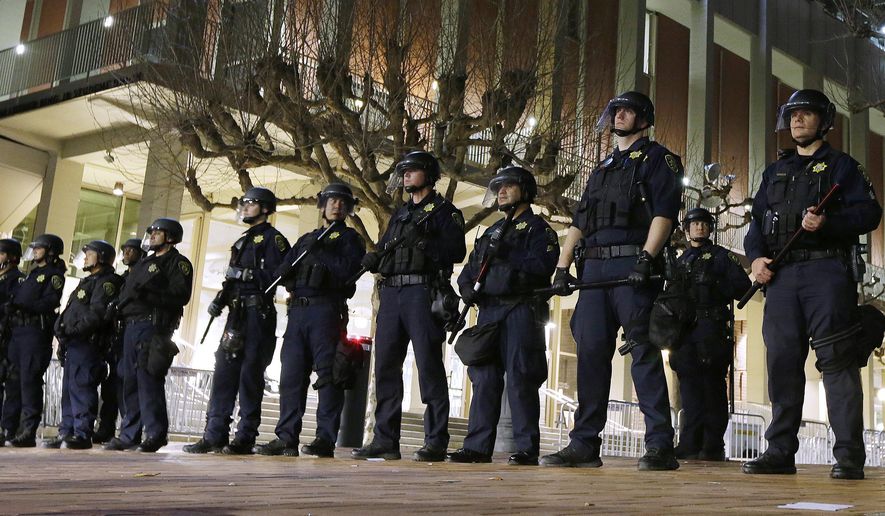OPINION:
The Foundation for Individual Rights in Education found in its recent “Spotlight on Speech Codes 2019” that across the country, at 466 of America’s so-called “top colleges and universities,” students are not allowed to fully exercise their First Amendment freedom of speech rights.
My, how the pendulum has swung far from the 1960s.
Back then, the University of California at Berkeley was dubbed protest central — the place where “agitators” go to learn how best to agitate, as J. Edgar Hoover famously wrote. Now?
“Settlement with conservative groups helps assure free speech on UC Berkeley campus,” read one San Francisco Chronicle headline this week, after Berkeley College Republicans won their two-year legal struggle against the school for halting three of the group’s planned speakers — Milo Yiannopoulos, David Horowitz and Ann Coulter — from speaking, and trying to halt a fourth, Ben Shapiro.
It’s like the agitators of 1960 have grown into the censors of 2018.
It’s not just Berkeley students who are suffering from this dangerous political correctness-slash-clamps on conservative thought.
“The vast majority of students at America’s top colleges and universities surrender their free speech rights the moment they step onto campus,” FIRE reported.
Specifically: Nearly 90 percent of American colleges “maintain policies that restrict or too easily could restrict student and faculty expression,” FIRE said. And in a rating system that gave red, yellow or green lights for First Amendment protections, with red belonging to the colleges that “clearly and substantially” restrict the most, nearly 29 percent of schools were in the red. Most of these “red” schools came from the District of Columbia and 11 states — Alaska, Delaware, Idaho, Illinois, Louisiana, Massachusetts, New Jersey, South Carolina, Vermont, Washington and Wyoming.
So what are some of these free speech restrictions placed on students and staff?
They include speech codes, free speech zones — which means areas outside these set boundaries are subject to restrictions on free speech — and the watering of normal due process rights that simply wouldn’t stand outside a college campus atmosphere. Oftentimes, the curtailments on free speech come under cover of discrimination and tolerance policies.
Barnard College in New York, for example, has a strict harassment policy that could see students severely punished for engaging in perceived offensive speech both “on or off campus.”
Offending others is a big no-no, as well.
Boston College has a policy that punishes those who view material on campus computers that “may be considered objectionable by some.” California State University at Fresno mandates “no email or message shall be created or sent, nor Web pages created, that may constitute intimidating, hostile, or offensive material based on gender, race, color, religion, national origin, sexual orientation or disability.”
The problem with most of these policies is their subjectiveness.
Who determines offensiveness? Who decides if an image or remark is intimidating?
In many cases, a finger-point is all it takes. From there, nail-biting administrators, worried about lawsuits, concerned about the potential for controversy — particularly when the controversy involves conservatism — rush to clamp, regulate, stifle and yes, censor.
“Just over 90 percent of public colleges maintain policies that don’t live up to their free speech obligations under the First Amendment,” FIRE found. “Private institutions are generally not bound by the First Amendment but are responsible for living up to their institutional commitments to free speech. More than 88 percent of private institutions fall short of those promises.”
This is unsatisfactory. Call it the censorship of the American mind; it sets the stage for the next generation to enter adulthood as docile, unquestioning sheep.
America’s places of higher learning are supposed to provide atmospheres of free thought, free inquiry, free expression — all aimed at stretching and developing the youthful mind. Chilling speech is not what parents pay for; censoring talk is not part and parcel of the proper college experience.
The good news is parents and students have the means of changing this dangerous anti-free speech trend on today’s campuses. It’s called tuition — and selectively choosing where the kids’ college money goes will do much toward changing, very quickly, these overly politically correct policies that simply clamp speech and censor expression.
• Cheryl Chumley can be reached at cchumley@washingtontimes.com or on Twitter, @ckchumley.




Please read our comment policy before commenting.